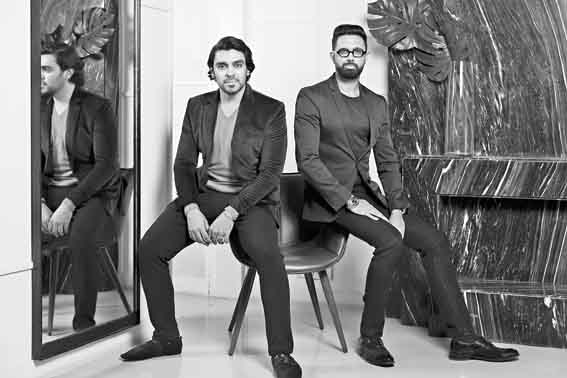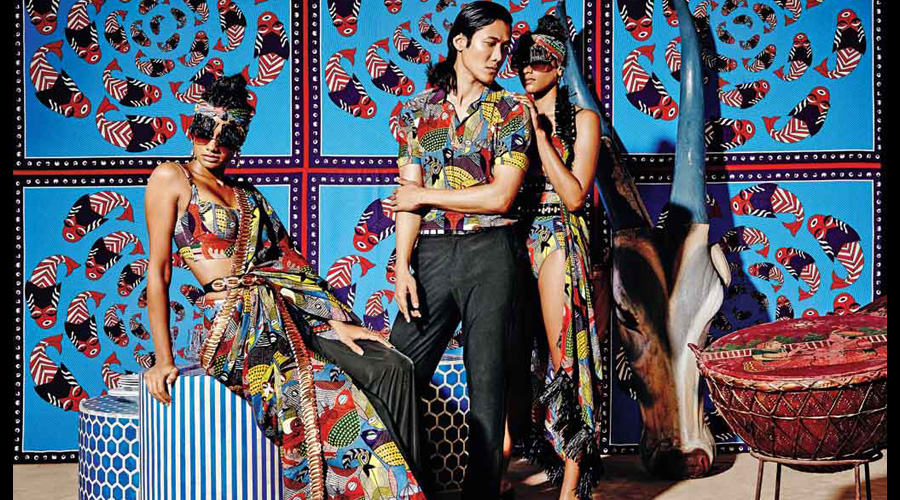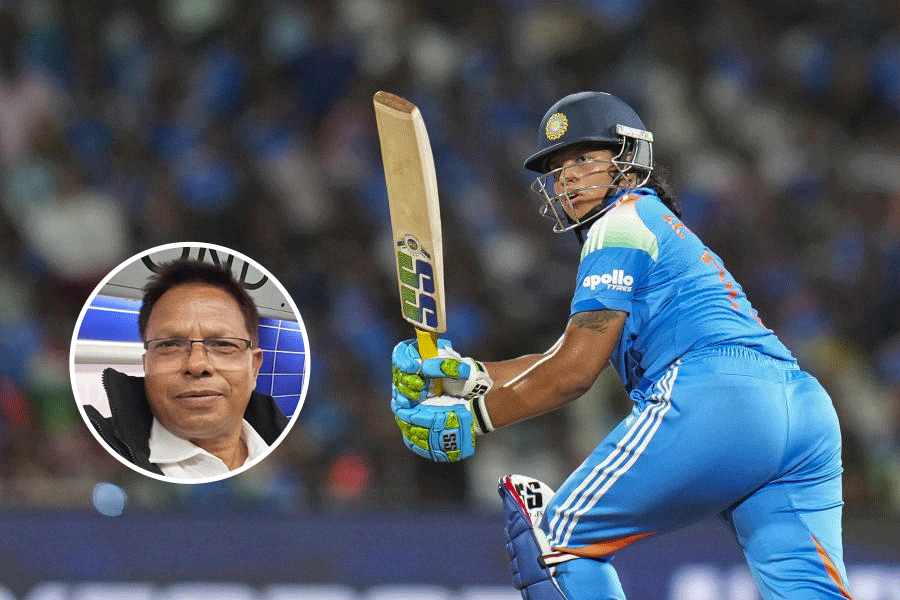They are different, cool, quirky and have made a swimsuit aspirational. Shivan & Narresh. Born out of Shivan Bhatiya and Narresh Kukreja’s love for travelling, the brand now wears many layers, celebrating women being the most prominent. As the label turns a decade, Narresh looked back at their journey of “problem-solving” with t2oS.

How did the brand start?
We met about 17 years ago at NIFT, New Delhi. I was 18 and Shivan was 19. We became good friends. Both of us were specialising in different things. I was studying fashion design and he was studying leather design. We realised that we had different skill sets. Shivan was excellent in illustration and good at communicating design and I was very good with graphics and making prints and software and technology in general. We started to utilise these skill sets to finish each other’s assignments (laughs).
One thing that really got us together was travel because both of us used to love travelling and that was one common goal. We started to take part in a lot of design competitions, which were announced at NIFT. We would pick out the competitions which, if we won, would take us to different countries. And, we would always win... almost an urban legend in NIFT. In those four years at NIFT, we must have travelled to some five-six countries. Our teachers were so supportive.
One of these design competitions that we had won was an Italian swimwear award and after we graduated, we got scholarships to study further in Italy. We purposely picked different courses because we were sure that we would start our own label. Since I had studied fashion, Shivan did his Masters in fashion and textiles and I did my Masters in luxury marketing. I was based out of Rome and Shivan out of Milan. For us, it became a great exposure. We realised that in that one year, we had to expose ourselves to as much international fashion as possible and the ecosystem of how this industry works. Every weekend, we used to travel to a fabric fair or a fashion fair or furniture fair or a light fair and fashion weeks. What we were going to come up with needed to be as distinguished as that. We were not going to do a product that already existed.
In 2008, we launched Shivan & Narresh at Cannes with a stitch-free swimwear collection. The seams were pasted. So you can do any style, but this was a couture way of doing swimwear. It was high-end and lasted limited number of washes. We came back to India in 2009 and wanted to go back to Europe again but then our families got emotional.
We took it up as a challenge. There was no industry here. We gave ourselves three years. We set up our studio in Delhi and March 2010 was our first fashion week in India, Lakme Fashion Week.
The first factory was Shivan’s room which was literally a one room in Gurgaon. We put up three machines there and hired one pattern master. We had to teach him swimwear pattern-making.

Why did you choose this particular category? Was it born out of travel love?
I’ll take you back to a conversation Shivan and I had while we were still studying in Italy in the summer of 2008. We were thinking of what we were going to launch with. We did a SWOT. Across all the design competitions, which category of clothing had we enjoyed doing the most.... The deciding factor for swimwear was that we both love travelling and it had to be a category that makes us travel. Swimwear was a global category and it not only would make us travel, but also our clients. So, swimsuits almost became a symbol of travel for us.
And then you were called the ‘bikini boys of India!’ The label was so niche...
All the women we got as our initial clients used to tell us that they had been wearing the same style of sports swimsuit since they were 13. Their bodies had changed with pregnancy. Look at the amount of evolution your body goes through as a woman. To force yourself to wear the same style for the rest of your life was so wrong. It was a big design problem that needed to be solved.

Body pride has been at the core...
None of these women were supermodels. Most of them were either married with kids or were about to get married and were shopping for their honeymoon. They were regular-bodied women.
That is how colour-blocking started. One of the most common problems that women would tell us is that they loved their shoulders but not their back or they had big hips but a nice bustline or ‘you can make the back deep, but not the front’. We realised that if it was about shifting focus, then why not put brighter colours on some and darker on some others.
How did you convince them to get into a bikini because a lot of them are still not comfortable?
Most of the women who came to us loved the idea of being around water. They fantasised wearing a bikini but never had the confidence to wear one. So, we had to start with maillots or one-piece swimsuits. We did that for two years, but stayed away from turning your swimsuit into cycling shorts. This was a safe zone, but not body flattering. Women in India are not tall. So, when you give a woman a boy shorts-style swimsuit, you are cutting the body into half, which makes them look shorter. We asked them to take a regular cut. It makes you look like you have longer legs.
By the time the third year came, the women who were with us for the first two years were now confident to try something more daring. We introduced the high-waisted bikini. Midriff is never a problem with Indian women because they wear saris and the top and bottom was like a one-piece swimsuit. The next two years were all about taking the customer from one piece to two piece. Then we introduced trikinis, which were one pieces but cut out strategically in random places because it is sexier and glamorous.

Who are the women who come to you now?
Interestingly, the profile is still similar. People think Shivan & Narresh would be catering to a 20-something girl, but our consumer graphic goes from a 28-year-old to a 55-year-old. We are a luxury holiday brand. By the time they are 30, there is more financial freedom. You are more willing to spend on yourselves. Shivan & Narresh is probably the only fashion brand in the country that’s a very self-love brand. You buy it when you have the confidence to face yourself in the mirror.
When did resortwear happen?
Again, it was about problem solving. Women said they loved their swimsuit but wanted cover-ups.
That’s how it started... kaftans, shirts, shirt-dresses, paneyos. This was the same woman who said that she was getting married and one of the ceremonies is by the pool or it is a beach wedding and she would like to jump into the pool in her sari.
In the last 10 years, millennials came of age. They became financially independent. There was a big shift in the way millennials consumed luxury. For them the experiences were a lot more important than the products. Travel became such a big thing for the millennials in the last 10 years. Even in fashion, they started to look for experiences. ‘When I am getting married on a beach, I want to walk barefoot because I want to feel the sand on my feet’. Those were the requests we started to get as an experimental fashion brand.
So we decided to make the weight of our jersey fabric light... say 80g georgette or chiffon, then we can make a sari out of it. That’s how a bikini sari was born. Here was a sari in which you couldn’t only just walk around and lounge, but also jump into the pool. It would function exactly like a swimsuit.
For lehngas, we decided that since scuba divers use neoprene, why not we make a lehnga of neoprene that will make it water-resistant and very light. The whole thing of carrying a 20kg lehnga for a destination wedding had to be redone. It became practical and hence was a big hit.

Art is at the heart of the brand…
All the art prints that you see are designed by me and all the silhouettes are designed by Shivan. I think if I wasn’t a fashion designer, I would have been an artist. Within art, graphics was something that really excited me. Art is a personal point of view. So personal that it is also unique. When you make that as a starting point for any new print, it ends up being so unique that it is instantly recognisable.
Your logo is interesting…
The iconographs. We have five animals representing a different holiday lifestyle. Snail is for beachwear, peacock represents resortwear, the dolphin represents cruisewear, the elephant represents safari and the reindeer represents skiwear. The idea was wherever you holiday, you only think of Shivan & Narresh. We will always have holiday and travel in our DNA.

Over the years you have ventured into lots of things…
We realised that there were so many pet parents, including ourselves, who would love to travel with dogs and cats, their biggest travel buddies. We thought if we could do twinning options for kids and parents on a beach, then why not for your dog and you? It was a fantasy-driven idea. With Heads Up For Tails (pet goods brand), we could not only manufacture, but also distribute because they have a wide network of distribution. You travelling with your pet is a great lifestyle.
The home space started as I was doing my own house and subconsciously, I was putting the Shivan & Narresh sensibility in a spatial way. It was easy for us to stretch the print universe to make Shivan & Narresh space, in the form of upholstery, cushions, wall art. We felt it would be a good extension to do Shivan & Narresh home. We do these limited-edition wall arts, these massive art prints. Then table linen, because we are fond of entertaining at home and then we do rugs. You can use them on your bed as a throw or as a table rug and you can travel with them and put it on the beach. The special fabric doesn’t catch sand. Last year, we also did our first collaboration in furniture with Bent Chair.
We also did our first beach couture bride. We have been into festivewear and destination clothing for five-six years now, but it was only last year that we designed the first wedding day outfit. The bride was Kaabia Grewal and she was getting married in Vietnam and because it was a sundowner and during the day, she wanted a white couture lehnga, but not like in a Christian wedding. This year, we extended that entire range into nine looks of couture pieces for weddings. We felt there was time for revolution again in wedding design. The pandemic has taught us what small weddings mean and for that couture needs to be redefined in a much more minimalistic way.

You revolutionised swimwear for men too...
Whenever we would travel, we would design our own clothes. Menswear started as a guilty-purchase category. We decided to do swim shorts and polos. The moment we launched, the sales figure went double digits. Then we decided to extend the men’s range to have resort tees, polos, espadrilles, swim shorts, trousers, loungewear....
How do you think social media has contributed to the evolution of Indian women?
Inevitably, it has made them find who they stand for and how they see themselves. The first swimsuit that I sold in Bombay went to this conservative Marwari girl who was getting married and in their home, they would still wear ghoonghats. She had shopped for a trikini. She was going to Maldives and there, her husband would actually see her for the first time in that swimsuit. ‘Please make me look so good that he falls in love with me for the rest of his life!’ was her request. Look at that emotion! That’s how much this category does for women. We have so many insecurities about our bodies and a category like this really helps you evolve.
What would you tell all the women reading this?
Guys, we are living in a golden age of self-love. This is the time to love and embrace yourself for the way you are. Look at our body icons today. We have Beyonce, Oprah Winfrey, Kim Kardashian. Size 10, 14, 16, 8… it does not matter. If you can love yourself, the world will love you.
Pictures: Shivan & Narresh and Sandip Das











